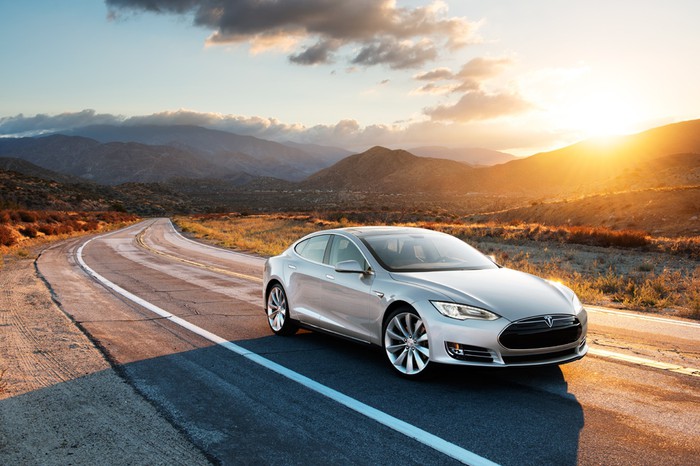
Last week, Tesla (NASDAQ:TSLA) reported ugly results for the first quarter of 2019. The electric car pioneer had warned of impending trouble earlier this month, but investors were still caught off guard by the scale of its losses. Tesla’s net loss of $4.10 per share — or $2.90 per share, excluding stock-based compensation costs — was worse than even the most bearish analysts’ estimates. On average, analysts had been expecting a loss of just $0.69 per share.
Not surprisingly, Tesla’s terrible Q1 results did nothing to dampen the enthusiasm of CEO Elon Musk. Indeed, Musk confidently predicted that Tesla will return to solid profitability in the second half of 2019 and will produce positive free cash flow beginning this quarter.
However, one comment Musk made during the Tesla earnings call should make investors extremely skeptical of these rosy predictions. Let’s take a look.
Tesla has a demand problem
A sharp sequential drop in vehicle deliveries was the main cause of Tesla’s first-quarter earnings wipeout. Tesla delivered about 63,000 vehicles last quarter, down by 31% from the fourth quarter of 2018. The Model S and Model X performed especially poorly, with 12,100 deliveries combined, down more than 50% compared to the company’s typical run rate for 2017 and 2018.
Part of the slowdown was driven by a planned increase in the number of vehicles in transit to customers outside the United States. Logistics problems also pushed some deliveries into the second quarter. That said, weak demand was the primary cause of the big decline in Model S and Model X deliveries.
Model 3 demand has cooled noticeably as well. Many investors had expected the introduction of the $35,000 standard-range Model 3 to create a huge backlog of demand that would take months to fill. Price cuts for higher-end variants should have added to that demand.
Instead, Tesla is currently promising deliveries within two weeks for all versions of the Model 3 across most, if not all, of the United States. That’s a huge change from a couple of years ago, when Elon Musk claimed the Model 3 reservations list was growing steadily even as Tesla was “anti-selling” the car, with no advertising, no discounts, and no test-drives available.
Musk expects a quick rebound in orders
Tesla’s projections that free cash flow and earnings will return to positive territory soon depend on a rebound in deliveries. The company’s official full-year guidance calls for 360,000 to 400,000 deliveries, including 90,000 to 100,000 in the second quarter. At the midpoint of those ranges, Tesla would have to deliver an average of 111,000 vehicles per quarter in the second half of 2019, 76% ahead of its Q1 delivery rate.
However, it’s becoming clear that order activity would need to accelerate dramatically to support that level of growth. During the Q1 earnings call, Musk stated, “So, with the recently announced product improvements on Model S and X, as well as continued expansion of Model 3 globally, we expect the order rate to increase significantly throughout the year … commensurate with our production levels.” He reinforced that point later in the call in response to an analyst’s question, noting that “people just generally don’t like buying cars in winter.”
It’s true that auto sales tend to be seasonally weak during January and February. However, the introduction of the $35,000 Model 3 and price cuts for the rest of Tesla’s portfolio should have boosted demand. Furthermore, March and April tend to be stronger months, so Tesla’s order activity should have already rebounded to whatever level is sustainable.
Instead, Musk’s comments on the earnings call indicate that he is counting on order activity to continue accelerating throughout 2019. That should be very worrisome for investors, because it means Tesla’s forecast for the rest of the year is likely built on unrealistic assumptions.
When it comes to Tesla, skepticism pays
Experience shows that Musk’s apparent confidence that demand will accelerate throughout 2019 doesn’t mean much. For example, Musk stated on Tesla’s first-quarter earnings call that he was “optimistic about being profitable in Q1 and for all quarters going forward.” Instead, Tesla lost more than $700 million last quarter and expects to report another loss in Q2.
In fact, there are good reasons to doubt that demand will recover, particularly in the U.S., which has historically accounted for the bulk of Tesla’s sales. First, Tesla has already exhausted the pool of pent-up domestic Model 3 demand. Second, the federal electric vehicle tax credit for Tesla purchases is set to fall by 50% ($1,875) on July 1, raising the effective price of a Tesla in the second half of 2019. Third, many potential buyers may choose to wait for the Model Y crossover that was unveiled last month. Crossovers are far more popular than sedans today.
Musk is trying increasingly outlandish tricks to pump up demand for Tesla vehicles, such as his recent claim that Tesla owners will be able to make up to $30,000 annually by renting out their vehicles through a robotaxi network as soon as next year. (Most experts agree that a wide rollout of robotaxis will take years or even decades to achieve.) That may persuade some consumers to buy a Tesla, but it isn’t likely to be a long-term game changer.
To be sure, there are plenty of interesting projects under way at Tesla. However, if history is a guide, they could all take longer than expected to execute. Meanwhile, demand is cooling for Tesla’s existing vehicles, which may lead to a big shortfall in deliveries in 2019 and 2020. That could further stress Tesla’s weak balance sheet and drive its share price even lower.





























